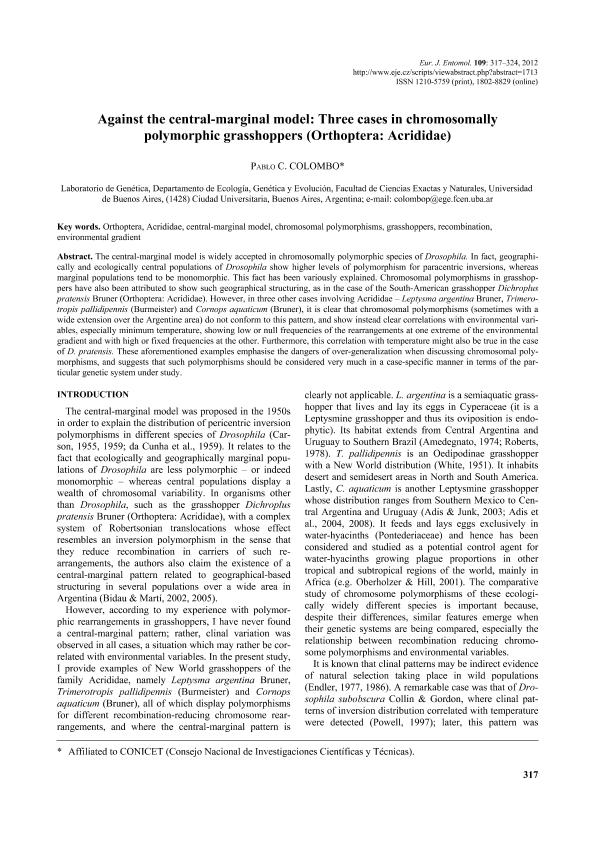Artículo
Against the central-marginal model: Three cases in chromosomally polymorphic grasshoppers (Orthoptera: Acrididae)
Fecha de publicación:
07/2012
Editorial:
Czech Academy of Sciences
Revista:
European Journal of Entomology (Ceske Budejovice)
ISSN:
1210-5759
e-ISSN:
1802-8829
Idioma:
Inglés
Tipo de recurso:
Artículo publicado
Clasificación temática:
Resumen
The central-marginal model is widely accepted in chromosomally polymorphic species of Drosophila. In fact, geographically and ecologically central populations of Drosophila show higher levels of polymorphism for paracentric inversions, whereas marginal populations tend to be monomorphic. This fact has been variously explained. Chromosomal polymorphisms in grasshoppers have also been attributed to show such geographical structuring, as in the case of the South-American grasshopper Dichroplus pratensis Bruner (Orthoptera: Acrididae). However, in three other cases involving Acrididae - Leptysma argentina Bruner, Trimerotropis pallidipennis (Burmeister) and Cornops aquaticum (Bruner), it is clear that chromosomal polymorphisms (sometimes with a wide extension over the Argentine area) do not conform to this pattern, and show instead clear correlations with environmental vari- ables, especially minimum temperature, showing low or null frequencies of the rearrangements at one extreme of the environmental gradient and with high or fixed frequencies at the other. Furthermore, this correlation with temperature might also be true in the case of D. pratensis. These aforementioned examples emphasise the dangers of over-generalization when discussing chromosomal polymorphisms, and suggests that such polymorphisms should be considered very much in a case-specific manner in terms of the particular genetic system under study.
Archivos asociados
Licencia
Identificadores
Colecciones
Articulos(IEGEBA)
Articulos de INSTITUTO DE ECOLOGIA, GENETICA Y EVOLUCION DE BS. AS
Articulos de INSTITUTO DE ECOLOGIA, GENETICA Y EVOLUCION DE BS. AS
Citación
Colombo, Pablo Cesar; Against the central-marginal model: Three cases in chromosomally polymorphic grasshoppers (Orthoptera: Acrididae); Czech Academy of Sciences; European Journal of Entomology (Ceske Budejovice); 109; 3; 7-2012; 317-324
Compartir
Altmétricas




